By Shannon Dryden, Nature Preschool Manager & Lead Teacher
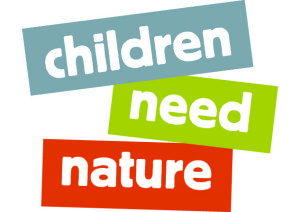
As the preschool manager and teacher at the Schuylkill Center Nature Preschool, it is so exciting to see the benefits of children spending time outdoors unfolding right before my eyes. The children have gained endurance and stamina since the beginning of the year. We now venture to ponds and places that are farther away on our trails and the children enjoy these excursions. For example after describing Wind Dance Pond, the children immediately began asking “Can we go there?” Nature Preschool took on the challenge and showed a tremendous amount of pride and sense of self exclaiming, “We made it to Wind Dance Pond!”
This year, I have had the joy of experiencing the seasons, animals, and plants with the children. Together, we have embarked on a journey of questioning, discovery, and increasing curiosity.
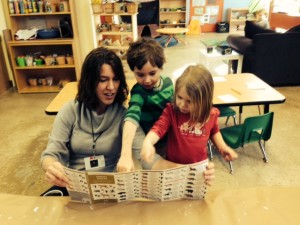 Wanting to share all of the wonderful activities and ways our children were forming relationships with our natural world, we jumped at the opportunity to present at the 2014 DVAEYC Conference which focuses on current topics, ideas, and discussions going on in the early childhood world. The theme of the conference was Take a Walk on the Wild Side! Connecting Children with Nature. After presenting and being a participant this spring, I was reminded of the possibilities the outdoors offer, and the ways that a young child’s development can be supported simply by engaging in unstructured outdoor play. Great discussions, networking, conversations, and sharing of lessons and activities culminated into a reaffirmation of the work that we do.
Wanting to share all of the wonderful activities and ways our children were forming relationships with our natural world, we jumped at the opportunity to present at the 2014 DVAEYC Conference which focuses on current topics, ideas, and discussions going on in the early childhood world. The theme of the conference was Take a Walk on the Wild Side! Connecting Children with Nature. After presenting and being a participant this spring, I was reminded of the possibilities the outdoors offer, and the ways that a young child’s development can be supported simply by engaging in unstructured outdoor play. Great discussions, networking, conversations, and sharing of lessons and activities culminated into a reaffirmation of the work that we do.
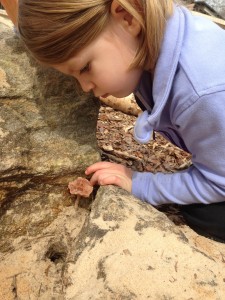
All young children are naturally curious about their environment and learn best when actively exploring the world around them. This allows them to strengthen their personal connection while developing feelings of kindness, respect, and compassion. As a gift, one of our Schuylkill Center families provided a caterpillar life cycle set which intrigued the children. They have enjoyed watching the caterpillars going through the stages of their life as they transform into butterflies. They continue to describe what they are seeing, saying, “Look, the caterpillars are almost ready to make their chrysalides.” The children are using their observational skills and continue to build their descriptive vocabulary just through this natural experience. After seeing their predictions come to life as they chrysalides appeared, the children showed signs of joy and their mouths and eyes widened while taking a closer look! They continue to categorize the types of bugs and insects that we see and are widening their factual knowledge. The children compare our painted lady caterpillars to the other caterpillars that we find on our explorations outside. They are able to compare and contrast sharing what they notice such as, “This caterpillar is a different color” or “It looks smaller.” Their continued curiosity shows their engagement and connection with what they are exposed to here at the Schuylkill Center. This is supporting the children in building positive relationships with each other, the outdoor world, and learning how we fit into the community.Our work and the conference allowed me to refocus on the jump that our children have taken as the weather is warming and new life is blossoming, growing, and appearing outdoors. The children are exploring texture as the rainy weeks have provided different surfaces to squish, mix, and mold. Discoveries of green are being found on our walks and hikes and the children are asking questions such as “What’s happening?” and
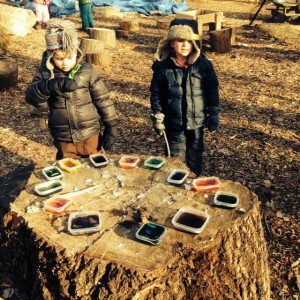
“What will that grow into?” They are building an understanding of the life cycle of plants and flowers and beginning to understand the interactions of the plants, animals, the weather, and climate. As they learn about the natural world, the children are continuing to develop their classification skills and develop socially, emotionally, cognitively, and physically. Young children learn best when they are able to construct their knowledge through play and active exploration of the environment. At Tall Trees Nature Playscape, the children begin to identify shapes, engage in measuring and comparing size, and explore cause and effect in building. They use big logs, cut pieces of wood and small sticks and branches for building. Engineering and science concepts are explored as the children talk to one another. They continuously ask each other questions such as, “Do you think this piece will fit here?” and share ideas or recommendations such as, “Maybe we need a longer log!”
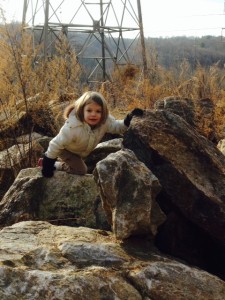
The most important thing that I have learned so far this year is how much the children truly connect with their special place, “the Schuylkill Center.” Every day, we walk around the Schuylkill Center and bump into a staff member. We take the opportunity to stop, ask questions, and engage in a discussion about what they are doing. This has led to the children building positive adult connections with all of our staff who they lovingly know by name. The children understand the roles our staff plays in the community, as well as our impacts on the environment and the space that we live in. This has all happened through play, interactive exploration, and social interactions. This is how young children learn the life skills that they will need. In the Nature Preschool, it is so exciting to see how nature drives the children in their self-directed exploration. Our children continue to demonstrate a growing knowledge of the world around them, build social skills, and are exposed to math, science, language, and literacy as it connects to our environment. Children need nature and as each moment passes by at the Schuylkill Center Nature Preschool, I understand this more, each new experience drives it home.
Children Need Nature is a monthly blog column from our Nature Preschool program. Read more posts here.
